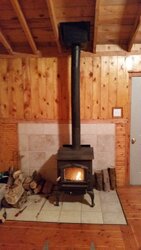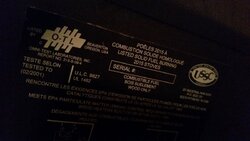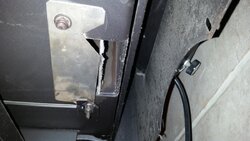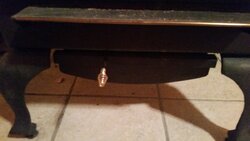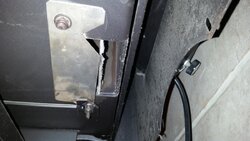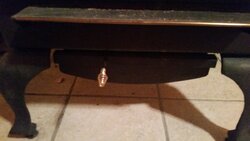Hello Everyone,
I apologize firstly since I'm sure some of these questions are answered by others, but I've been going through post after post and there is just a ton of information.
Firstly I'd like to say I'm new to wood burning, I originate from the sunny thermostat controlled apartment in Southern California and moved to middle Montana area. The most we had was a fireplace which was for aesthetic looks and burns, not heating a house. So much of this is foreign (like all beginners) and I have some concerns.
The stove I have in our rented cabin is made by United States Stove Company, I've looked on their website to see which model looks similar and it looks like we have a 2,000sqf stove for a 500sqft cabin which is divided into two rooms (about even). However, the design is different as this one stands on 4 legs rather than a stand like the one online, but other than this it looks identical.
My query begins with this.
On our arrival we had a significant amount of trouble lighting it (our landlord squirts a bit of diesel on a rag and lights it with the door cracked so no combustion), to which "yikes" was a quick response of mine mentally. It does however get it blazing quickly. The first few nights I had a lot of trouble starting it with/without diesel. It smoked a lot, it back puffed, and set off our smoke alarm. Newbie mistakes (I hope). I couldn't for the life of me keep the fire going once I closed the front door. So I had to continually leave it cracked or it would die.
Fast forward a 10 days. I've got it going in 30min, a bed of coals in an hour, and I can close the door and still have it burning. Success! But now I'm having a problem with it putting out huge amounts of heat and still dies about every other hour unless attended. It chews through logs pretty quickly. The wood I'm using is Pine. Yes I know, a soft wood with lots of ash and easily dirties the chimney. But most the places I called out here only sell pine wood or some small mix which runs about 150 a cord split in 1/2 to 1/3's. I've taken the liberty to split some into 1/4's to get the fire going easily. I hope this sounds correct (despite it being pine...).
My problem currently is my damper is closed/shut and while it does slow the fire it's still going through a log an hour 1/2 loge or 1/3 log if dense. That seem quick to me but who am I to know. My landlord and neighbor both say they can run a night long burn off 2-3 logs, which is my problem.
If I go to bed at 10-12pm, my fire is dead with burned out coals by 1am MAX. Meaning by 3am it's freezing in the house and I'm not even into negative weather yet.
How do I get a nice over night burn? I've tried different stacking techniques here with smaller pieces, then large, and finally a log but they kind of all just blow up and burn, just super hot if more wood. I need to figure this out sooner than later as I'm heading into negative weather soon, and for the first time in my life I might add. . .
I love it here in Montana, I love the clean air of the country, being a hour from the city, and working from home. I love the animals to the door, the people, etc. But I'm stuck on this stove. It's the one part that has yet to fall into place.
I keep getting told "every stove is unique, each has a personality that you got to figure out how to work with it". I've tried hard with just information and not asking for several weeks now. But I feel not asking is stupider at this point...
Thing's I've considered
1. It's unknown even to the landlord when the chimney was last cleaned.
2. Possible leak since the fire should die if the damper is closed yet it burns slower (I've tried smoking the box to see leaks but I can't find any).
3. Not enough pressure in the room (opened a nearby window but it didn't seem to change any)
4. Burn harder wood (If only I could find some)
5. Learn to get up every other hour in the night...
With all these things considered does anyone have any extra input? Any thoughts, suggestions, or senior advice?
What I plan on doing soon:
Having the chimney professionally serviced for cleaning (seems dangerous not knowing the condition).
I appreciate all thoughts and advice, thanks for listening to my somewhat rant about my stove problems.
I apologize firstly since I'm sure some of these questions are answered by others, but I've been going through post after post and there is just a ton of information.
Firstly I'd like to say I'm new to wood burning, I originate from the sunny thermostat controlled apartment in Southern California and moved to middle Montana area. The most we had was a fireplace which was for aesthetic looks and burns, not heating a house. So much of this is foreign (like all beginners) and I have some concerns.
The stove I have in our rented cabin is made by United States Stove Company, I've looked on their website to see which model looks similar and it looks like we have a 2,000sqf stove for a 500sqft cabin which is divided into two rooms (about even). However, the design is different as this one stands on 4 legs rather than a stand like the one online, but other than this it looks identical.
My query begins with this.
On our arrival we had a significant amount of trouble lighting it (our landlord squirts a bit of diesel on a rag and lights it with the door cracked so no combustion), to which "yikes" was a quick response of mine mentally. It does however get it blazing quickly. The first few nights I had a lot of trouble starting it with/without diesel. It smoked a lot, it back puffed, and set off our smoke alarm. Newbie mistakes (I hope). I couldn't for the life of me keep the fire going once I closed the front door. So I had to continually leave it cracked or it would die.
Fast forward a 10 days. I've got it going in 30min, a bed of coals in an hour, and I can close the door and still have it burning. Success! But now I'm having a problem with it putting out huge amounts of heat and still dies about every other hour unless attended. It chews through logs pretty quickly. The wood I'm using is Pine. Yes I know, a soft wood with lots of ash and easily dirties the chimney. But most the places I called out here only sell pine wood or some small mix which runs about 150 a cord split in 1/2 to 1/3's. I've taken the liberty to split some into 1/4's to get the fire going easily. I hope this sounds correct (despite it being pine...).
My problem currently is my damper is closed/shut and while it does slow the fire it's still going through a log an hour 1/2 loge or 1/3 log if dense. That seem quick to me but who am I to know. My landlord and neighbor both say they can run a night long burn off 2-3 logs, which is my problem.
If I go to bed at 10-12pm, my fire is dead with burned out coals by 1am MAX. Meaning by 3am it's freezing in the house and I'm not even into negative weather yet.
How do I get a nice over night burn? I've tried different stacking techniques here with smaller pieces, then large, and finally a log but they kind of all just blow up and burn, just super hot if more wood. I need to figure this out sooner than later as I'm heading into negative weather soon, and for the first time in my life I might add. . .
I love it here in Montana, I love the clean air of the country, being a hour from the city, and working from home. I love the animals to the door, the people, etc. But I'm stuck on this stove. It's the one part that has yet to fall into place.
I keep getting told "every stove is unique, each has a personality that you got to figure out how to work with it". I've tried hard with just information and not asking for several weeks now. But I feel not asking is stupider at this point...
Thing's I've considered
1. It's unknown even to the landlord when the chimney was last cleaned.
2. Possible leak since the fire should die if the damper is closed yet it burns slower (I've tried smoking the box to see leaks but I can't find any).
3. Not enough pressure in the room (opened a nearby window but it didn't seem to change any)
4. Burn harder wood (If only I could find some)
5. Learn to get up every other hour in the night...
With all these things considered does anyone have any extra input? Any thoughts, suggestions, or senior advice?
What I plan on doing soon:
Having the chimney professionally serviced for cleaning (seems dangerous not knowing the condition).
I appreciate all thoughts and advice, thanks for listening to my somewhat rant about my stove problems.
Attachments
Last edited:


